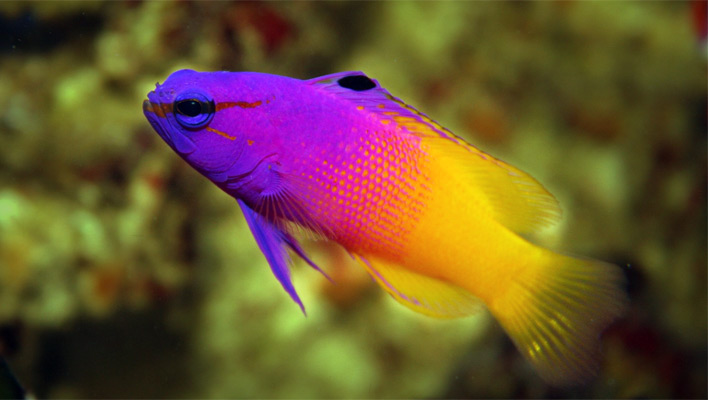One of the true piscine treasures hailing from the Caribbean is the royal gramma, a.k.a. the fairy basslet (Gramma loreto). Not only is this little gem a real showstopper aesthetically speaking, but it’s also a hardy, beginner-friendly, and generally very peaceful aquarium candidate. What’s more, it’s a great choice for smaller aquariums and just about as reef-safe as they come.
Sports gorgeous colors
Chromatically speaking, few reef fish have anything on the royal gramma with its gorgeous Easter-egg coloration. The anterior half of its body is a dazzling magenta to purple, giving way around mid-body to a bright orangish-yellow posterior. Dark lines originating at the mouth extend diagonally upward past the eye, and a small, dark spot is visible near the leading edge of the dorsal fin.
Suited to smaller tanks and reef systems
Reaching only about 3 inches in maximum length and typically remaining in very close proximity to its niche in the rockwork, G. loreto does not demand an especially sizeable system or a great deal of open swimming space. A 30-gallon tank is adequate minimum housing for this species. It’s also perfectly trustworthy around corals and other sessile invertebrates and, thus, a perfect choice for reef systems.
Do be aware, however, that G. loreto is a renowned jumper. Make sure your specimen’s tank is well covered, especially when it’s newly introduced and still getting settled in your system.
Loves rocky aquascaping—and not bound by gravity
In nature, G. loreto is apt to be found hiding in a cave or crevice or beneath a rocky overhang on the reef, and it will seldom venture far from its preferred hidey hole. That means ample rockwork arranged to provide lots of retreats is a must in the aquarium.
One of the more amusing characteristics of this species is its propensity to orient itself with its belly toward any nearby hard surface, whether it happens to be the floor, wall, or ceiling of its cave. So, it’s not unusual—or any cause for alarm—to see a royal gramma specimen positioned completely upside down or on its side within its rocky refuge.
An eager feeder
It’s seldom difficult to initiate a feeding response in G. loreto, and it will readily accept a wide range of aquarium fare. Its natural diet consists primarily of zooplankton and small benthic crustaceans, so small meaty foods, such as mysid shrimp, enriched brine shrimp, plankton, and chopped crustacean meat, are ideal. However, in time, it will dash out of hiding to grab just about anything edible and suitably sized that drifts close by its hiding place, including dry pellets and flakes.
Peaceful toward most tankmates
G. loreto is relatively unaggressive and will coexist peacefully with a wide variety of different fish species, provided they aren’t especially aggressive themselves, they aren’t too similar in appearance, and they don’t try to claim the gramma’s cherished hidey hole for their own. Of course, any larger, predatory fish that might try to make a meal of the gramma should be left out of the tank, as well.
Beware imposters!
One note of caution: You might come across a species at your local fish store that is almost identical to the royal gramma in size, coloration, and common name. I’m talking about the royal dottyback (Pictichromis paccagnellae). While this species is also very hardy, easy to feed, reef safe, and suited to smaller systems, it is extremely aggressive and very difficult to match up with fish tankmates that it won’t torment.
P. paccagnellae can be distinguished from G.loreto by looking for a few key features. One is the transition between the purple and yellow coloration on the body. On P. paccagnellae, the nasty species, this transition is abrupt and very clearly delineated, whereas the purple color fades into the yellow on G. loreto. Also, P. paccagnellae lacks the dark, diagonal lines extending from the mouth through the eyes as well as the dark spot on its dorsal fin.



